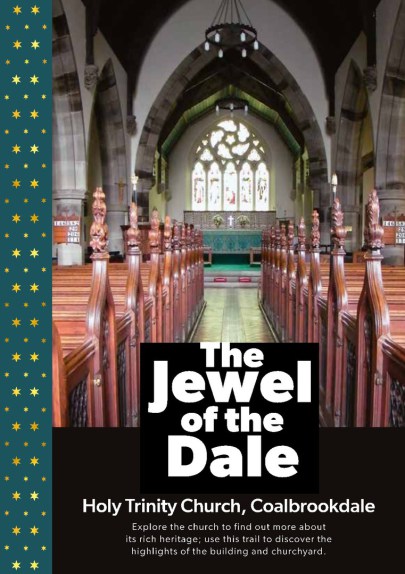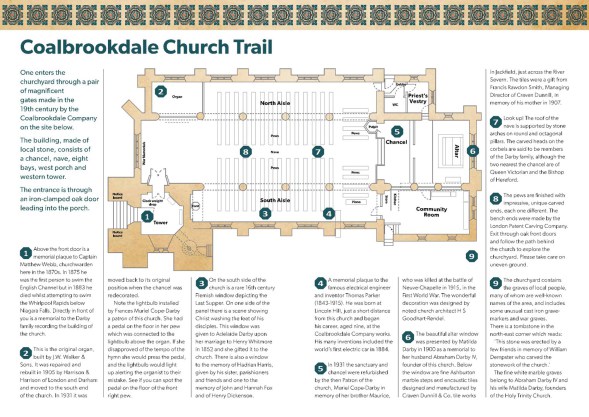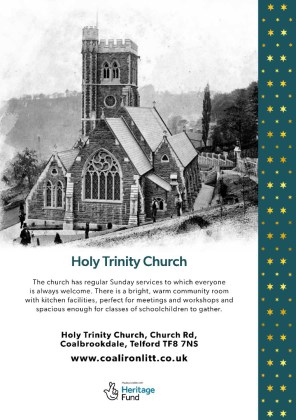The Treasurer of Holy Trinity Church is retiring after many years, therefore, we are looking for someone who would like to take on this voluntary role. If you are interested, please contact Revd. Ernest Okeke on 'Contacts and Links' page.
Holy Trinity, Coalbrookdale
Our beautiful church is now open every day between 10 a.m. and 3 p.m. The National Lottery Heritage Fund provided us with a generous grant to showcase the amazing heritage of our church and it's links to Abraham Darby and the world-famous industry in the Ironbridge Gorge. Do come and find out about the church's history and the amazing people who have featured in it's rich heritage. You can follow the family-friendly heritage trail, relax in the new Community Room or simply spend a moment or two in peaceful, quiet reflection, or sit outside on a bench and enjoy the view across the dale.
We are proud of our strong links with the Gorge Museums; Coalbrookdale Church is just a short walk from the fascinating sites of Enginuity and the Museum of Iron.
The Jewel of the Dale
Endowed in 1851 by Abraham Darby IV, with a superbly decorated chancel ceiling, fine stained glass windows including rare 16th century flemish depiction of The Last Supper. Look up and see historic stone carvings. Walk down the centre isle and see individually carved wooden pew ends with iron gates. Near the entrance is a Harrison & Harrison 3 manual pipe organ and as you leave look above the heavy wooden door and see the monument to Captain Webb.
In the year 1851 there was no such parish as Coalbrookdale, although the name of the village was famous in many parts of the world by reason of the renowned ironworks; the village of Coalbrookdale was originally part of the parish of Madeley. The earliest record of worship in the Dale is found at the time of the rebuilding of Madeley Parish Church in 1794-7; at that time a room at the Coalbrookdale British Boys’ School (provided by the Coalbrookdale Company) was used for Sunday worship and the administration of the sacraments. In 1850 a room in the school was licensed for church worship and became the first formal Anglican church in the village.reated from part of Madeley.
In 1845 the parish of St. Luke, Ironbridge, was ce parish was again divided to form the parish of Holy Trinity, Coalbrookdale, taking also some land from the neighbouring parish of Dawley
Magna.
Abraham Darby IV had been baptized an Anglican at Little Wenlock in 1849 and promised to endow the new parish with £100 a year. With the support of the Darbys a new
church was planned. The foundation stone was laid by Abraham’s wife, Matilda Frances, on 11th December 1851 and the completed building was consecrated by the Bishop of Hereford on 25th July
1854.
OUR PATRON
Reflecting on the conflicts and climate crises in our world today, how furtunate we are to live in this peaceful corner of the beautiful Shropshire countryside. However, it is not so long ago that people in the Dale experienced pitiful lives with daily exposure to toxic fumes, smoke and dust and the constant noise and stink of blast furnaces. They endured long days of hard labour for very little reward, but at least the ironworkers could be thankful to the Darby family who, with their Quaker heritage, were known as good, caring employers. Their Coalbrookdale Company provided a school, workers cottages and lovely country walks. In times of food shortage, Abraham Darby III even bought up farms to grow food for his workers. The fast-growing communities in the Ironbridge Gorge in the 18th and 19th centuries soon olaboured for their own church and parish separate from the ancient town of Madeley. Thus, St. Luke's Church, overlooking the famous Iron Bridge, was built in 1836 and their own parish (including Coalbrookdale) formed in 1845.
Step forward Abraham Darby IV, our patron. 'A thoroughly practical ironmaster', he took charge of the Coalbrookdale Company in 1832 with his brother Alfred and cousin Francis. Together they restored and transformed the company. Their famous art castings stimulated recovery and in 1851 the Coalbrookdale Foundry was the biggest in the world. Abraham married Matilda, his cousin, in 1839. They decided soon afterwards that they would no longer be Quakers and, after a series of family disagreements, Abraham relinquished his management of the company. Having been baptised into the Church of England, Abraham gave £6,000 towards the building of a new church and a further £7,000 as an endowment. His sister-in-law, Adelaide, provided the site. In 1851 the new parish of Coalbrookdale was formed and the church building began. Abraham gave his fine house, The Chestnuts on Darby Road, as a vicarage.
As a patron of the Church, he oversaw the appointment of the clergy (this patronage continued in the Darby family until 1959 when Lady Labouchere conveyed it to the Bishop of Hereford). Holy Trinity Church was designed by Reeves and Voysey, the finest architects in the land. With no expense spared, it was completed in 1854 and consecrated on 25th July. Over the following years, the church was endowed with fabulous 'treasures' by the Darby family including fine examples of ironwork produced at the Coalbrookdale Works. Next year Holy Trinity Church will be 170 years old, a fitting tribute to the expertise of the builders and architects and the generosity of our famous patron Abraham Darby IV, whose grave in white marble can be seen in the church yard behind the church.
Location
Church Road, Coalbrookdale, Telford, Shropshire TF8 7NS








